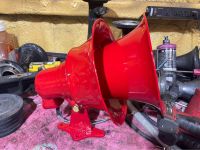Type F
| Type F
Model F | |
 A restored 3rd-generation Type F. | |
| Company | Sterling Siren Fire Alarm Co. |
|---|---|
| Produced | Late 1910s-early 1950s |
| Type | Directional Electromechanical |
| Sound output | 117 dB @ 10 ft (outdoors)
103 dB @ 10 ft (indoors)
|
| Horsepower | ⅕ hp |
| Voltage | 110-120 V AC/DC |
| Succeeded by | F-2 |
Type F (Factory siren), later known as Model F, is a small industrial siren that was produced by the Sterling Siren Fire Alarm Company (originally the Inter-State Machine Products Company) for a period of roughly 60 years and was a significant competitor in the industrial and short-range fire siren markets. Despite being rather rare today, these sirens are still known to be loud and reliable for their purpose.
History
Advertised as the "Sterling Factory Siren", the Type F was intended for indoor use as an industrial siren and a fire alarm, providing a distinctive loud signal. It was designed to compete with sirens such as the Model A, D, L, and various other small sirens such as the Sparton Model 35 and H.O.R. Siro-Drone Type 87 in this market. The earliest Type F sirens, known as the 1st-generation, resembled the horn-style sirens that were common at the time. 1st-generation Type F sirens used a long, thin intake horn which thinned out in the center before expanding to the width of the rotor, which would help suck air into the siren better; however, this was more difficult to manufacture. The siren also used a simple rounded projector.
By the mid-Interstate era in the 1920s, the Type F would be heavily redesigned with a simpler design, with a simple cone-shaped intake horn and projector, with rings on each of them. Its overall design was much closer to the Federal Type A compared to other generations. The 3rd-generation was introduced as early as 1932 and established the overall design the siren would use throughout most of its production run, with an ornate bell-shaped intake horn and projector, and a simple, 3-step motor cover. The 4th-generation was largely the same as the 3rd-generation, with minor design changes to the motor cover. The vast majority of surviving units are 3rd and 4th-generation units. The Type F sold fairly well throughout its lifetime, but it never sold as well as Sterling's larger sirens such as the Model M and the Vertical Siren; the siren would be succeeded by the Model F-2 in the early 1950s.
Design

The Type F and Model F-2 are small electric sirens with a directional design, designed to be mounted on ceilings, walls, and other surfaces. The sirens use a small aluminum 8-port rotor and stator driven by a ⅕ hp AC/DC universal motor, running on 110 V AC as standard. The motor operates at 14,000 rpm, causing the sirens to be extremely high pitched. The sirens reach 117 dB at 10 ft outdoors, while reaching 103 dB at 10 ft in an indoor ambient environment. The Type F uses brass sleeve bearings, which require periodic lubrication to work correctly. The motor can be lubricated through two oil cups placed on top of the rear motor housing. The Type F is designed similarly to a vehicular siren, with the siren being attached to a metal swivel mount underneath that allows the siren to be aimed vertically.

The sound is projected through the siren's flared intake horn, as well as a bell-shaped skirt. Originally, the intake horn was much thinner and longer, potentially to compress the air as air enters, but was later changed to be shorter and wider. The motor is covered by a protective housing on the rear of the siren, with the power cable going through the bottom of the cover. The motor cover and motor itself are quite fragile if the siren is handled roughly and are prone to cracking or breaking if disassembled without care. The siren has a directional design, projecting in one direction, like many small sirens. Unlike most sirens, however, the siren completely lacks finger guards on the stator, which can lead to personal injury if the siren is mishandled. The siren could optionally be mounted vertically facing downwards, with a metal pipe attached to the intake horn allowing it to stand vertically.
Vertical Type F and F-2 units were commonly paired with Eagleux beacons as a street clearing unit, flashing a red "FIRE" light and activating the siren to clear the street for volunteer firefighters.
Gallery
-
A 1st-generation Type F with the original intake horn, on display in a museum near Piru, CA.
-
A 2nd-generation Type F.
-
A 4th-generation Model F owned by ArxCyberwolf.


